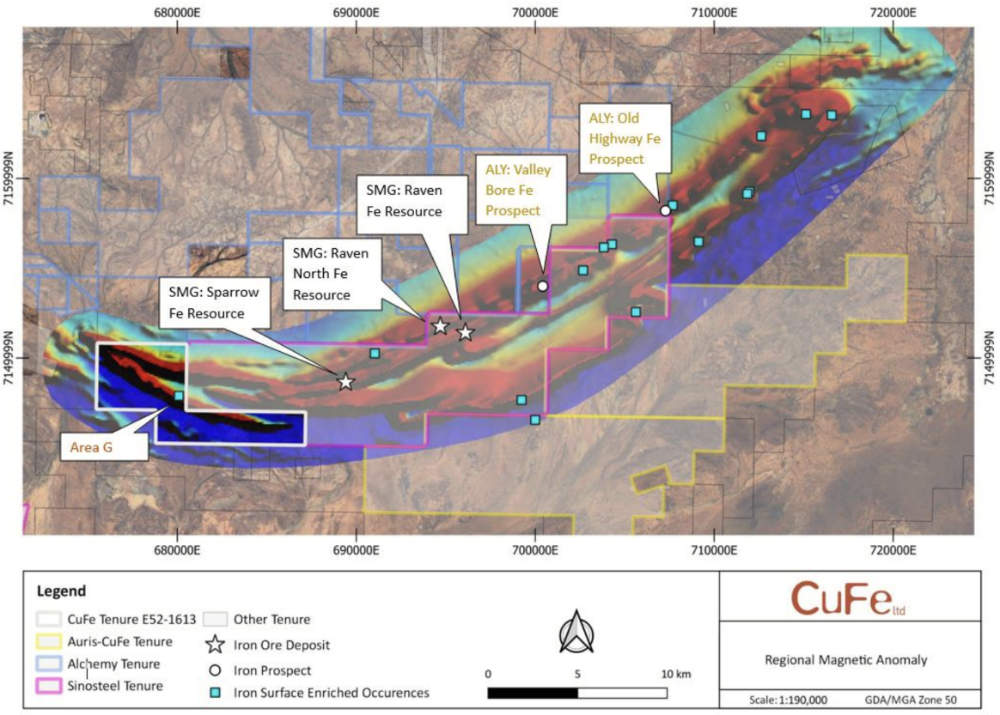CuFe rock chip sampling uncovers iron at its Bryah Basin project

Iron ore has been found at CuFe’s E52/1613 tenement. Pic: Getty Images
- CuFe rock chip sampling returns high-grade iron at E52/1613 within its Bryah Basin project
- 80m by 40m zone of surface iron enrichment identified by sampling
- Corridor of potential iron enrichment with a strike length of up to 7.2km identified
Special Report: CuFe’s identification of iron ore potential within tenement E52/1613 within its Bryah Basin project portfolio has been validated by rock chip sampling returning assays of up to 60.63% iron with low impurities.
The Bryah Basin project includes a package of tenements under various joint ventures and farm-ins, with a primary focus on the potential for gold and copper mineralisation.
E52/1613 is wholly owned by CuFe’s (ASX:CUF) subsidiary Jackson Minerals and covers 34km2 of ground about 95km north of Meekatharra, WA.
Several roads and access tracks extend from the Great Northern Highway about 10km to the south and the Ashburton Downs-Meekatharra Road that passes 15km to the west, providing excellent access to the project area.
The tenement sits within the Robinson Range Formation that contains banded iron formations (BIF) and hematitic shales that outcrop within the east-west trend that strikes over 30km.
BIF thicknesses are variable along strike and range from less than 50m and up to 400-500m.
Supergene enrichment along the BIF outcrop hosts iron in hematite and goethite with grades ranging from 50% to 65%.
Highlighting this potential, Sinosteel has reported three resources – Raven, Raven North and Sparrow – that have combined resources of 9.3Mt grading 56% iron, while at the end of May, Alchemy Resources (ASX:ALY) reported high-grade rock chips from the Valley Bore prospect just 21km east from E52/1613.
Little iron ore exploration has been conducted on the tenement save surface gravity surveying, surface rock chip sampling and reconnaissance mapping followed by two reverse circulation holes carried out by Pepinnini Minerals between 2008 and 2012.
A wide spaced regional rock chip sampling campaign carried out in 2009 returned 21 samples with grades of 50.8-62.8% iron.

First pass reconnaissance draws a bead on iron
CUF’s first pass reconnaissance mapping and rock chip program was concentrated to the west of the tenement where the BIF outcrop in a tight synclinal fold hinge.
This Stage 1 work mapped out and sampled an 80m by 40m zone of surface iron enrichment with rock chips returning assays of between 51.72% and 60.63% iron.
Local structural complexity has also been observed and the surface enrichment could be an indicator of further mineralisation at depth and along strike.
A prospective corridor of enrichment has been identified along the BIF range coincident with further high-grade rock chips taken ~1.2km to the east though further detailed mapping and rock chip sampling is required to define the extent of surface iron ore enrichment.
Stage 2 is broadly defined as a potential area of further enrichment along the BIF range to the east where historical high-grade rock chip samples were collected by Pepinnini across the trend, including target Area G by Soulis in 1970.
The two stages provide a corridor of potential enrichment to explore with a strike length of up to 7.2km.
“Following a review of our Bryah Basin package we have identified prospectivity for iron ore within E52/1613 located along the Robinson Range,” executive director Mark Hancock said.
“Our first partial reconnaissance of the tenement has identified a pod of enrichment that is supported by high grade Fe rock chips and further illustrates the breadth of opportunity of our exploration portfolio that CuFe shareholders have exposure to.
“Although this is not the highest priority within our portfolio (where the focus is on exploration targets for future facing minerals including copper at Tennant Creek, lithium at North Dam and niobium in the West Arunta), we will follow up with more mapping and sampling along strike to further test the potential and to identify drill targets.
“The project logistics are favourable and offer potential for the style of low Capex DSO project we have experience in developing and executing.”
Next steps
CUF plans to carry out further detailed mapping and rock chip sampling later this quarter to further define the extent of iron enrichment within Stage 1 and Stage 2.
This article was developed in collaboration with CuFe, a Stockhead advertiser at the time of publishing.
This article does not constitute financial product advice. You should consider obtaining independent advice before making any financial decisions.
Related Topics
UNLOCK INSIGHTS
Discover the untold stories of emerging ASX stocks.
Daily news and expert analysis, it's free to subscribe.
By proceeding, you confirm you understand that we handle personal information in accordance with our Privacy Policy.








